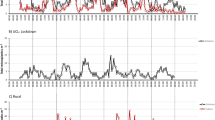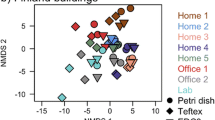Abstract
Airborne microplastics have been identified throughout the Northern Hemisphere in several studies. Synthesising measurements from multiple studies to derive a global distribution of airborne microplastics is difficult because no standard sampling protocol currently exists. Furthermore, measurements from the Southern Hemisphere are largely absent. We undertook a pilot study to test four different deposition samplers and their efficacy in collecting microplastics: a bottle with a funnel attached, an open beaker, a petri dish covered in double-sided adhesive tape and an automatic wet deposition collector. The four samplers were deployed to a suburban site in Christchurch, New Zealand, for four 6-day sampling periods. It was originally hypothesised that the funnel would improve sample retention by limiting resuspension; however, the open beaker was found to be similarly effective. We were unable to assess the effectiveness of the automatic wet deposition collector robustly due to low rainfall during the sampling periods. The adhesive tape sampler proved impractical. Particles collected from all samplers were inspected and classified as microplastics according to a visual screening criteria. Fibres, films, fragments and beads were identified, with fibres being the dominant morphotype (90%); however, only 10% of suspected microplastics were confirmed as plastic following μFTIR spectroscopy. Overall, we recommend the use of a funnel sampler or open beaker for future deposition studies. This is the first study of airborne microplastics in New Zealand and adds to a growing body of evidence as to the widespread nature of microplastics in the atmosphere.





Similar content being viewed by others
References
Allen, S., Allen, D., Phoenix, V. R., Le Roux, G., Durántez Jiménez, P., Simonneau, A., et al. (2019). Atmospheric transport and deposition of microplastics in a remote mountain catchment. Nature Geoscience, 12(5), 339–344. https://doi.org/10.1038/s41561-019-0335-5.
Amato-Lourenço, L. F., dos Santos Galvão, L., de Weger, L. A., Hiemstra, P. S., Vijver, M. G., & Mauad, T. (2020). An emerging class of air pollutants: Potential effects of microplastics to respiratory human health? Science of the Total Environment, 749, 141676.
Amodio, M., Catino, S., Dambruoso, P. R., de Gennaro, G., Di Gilio, A., Giungato, P., Laiola, E., Marzocca, A., Mazzone, A., Sardaro, A., & Tutino, M. (2014). Atmospheric deposition: Sampling procedures, analytical methods, and main recent findings from the scientific literature. Advances in Meteorology, 2014(161730). https://doi.org/10.1155/2014/161730.
Bakker, I., van der Voordt, T., Vink, P., de Boon, J., & Bazley, C. (2015). Color preferences for different topics in connection to personal characteristics. Color Research & Application, 40(1), 62–71. https://doi.org/10.1002/col.21845.
Bergmann, M., Mützel, S., Primpke, S., Tekman, M. B., Trachsel, J., & Gerdts, G. (2019). White and wonderful? Microplastics prevail in snow from the Alps to the Arctic. Science Advances, 5(8), eaax1157. https://doi.org/10.1126/sciadv.aax1157.
Brahney, J., Hallerud, M., Heim, E., Hahnenberger, M., & Sukumaran, S. (2020). Plastic rain in protected areas of the United States. Science, 368(6496), 1257–1260. https://doi.org/10.1126/science.aaz5819.
Bridson, J. H., Patel, M., Lewis, A., Gaw, S., & Parker, K. (2020). Microplastic contamination in Auckland (New Zealand) beach sediments. Marine Pollution Bulletin, 151, 110867. https://doi.org/10.1016/j.marpolbul.2019.110867.
Cai, L., Wang, J., Peng, J., Tan, Z., Zhan, Z., Tan, X., et al. (2017). Characteristic of microplastics in the atmospheric fallout from Dongguan city, China: Preliminary research and first evidence. Environmental Science and Pollution Research, 24(32), 24928–24935. https://doi.org/10.1007/s11356-017-0116-x.
De Falco, F., Cocca, M., Avella, M., & Thompson, R. C. (2020). Microfiber release to water, via laundering, and to air, via everyday use: A comparison between polyester clothing with differing textile parameters. Environmental Science & Technology, 54(6), 3288–3296. https://doi.org/10.1021/acs.est.9b06892.
Dehghani, S., Moore, F., & Akhbarizadeh, R. (2017). Microplastic pollution in deposited urban dust, Tehran metropolis, Iran. Environmental Science and Pollution Research, 24(25), 20360–20371. https://doi.org/10.1007/s11356-017-9674-1.
Dris, R., Gasperi, J., Saad, M., Mirande, C., & Tassin, B. (2016). Synthetic fibers in atmospheric fallout: A source of microplastics in the environment? Marine Pollution Bulletin, 104(1), 290–293. https://doi.org/10.1016/j.marpolbul.2016.01.006.
Fernández-González, V., Andrade-Garda, J. M., López-Mahía, P., & Muniategui-Lorenzo, S. (2020). Impact of weathering on the chemical identification of microplastics from usual packaging polymers in the marine environment. Analytica Chimica Acta, 1142, 179–188.
Ganguly, M., & Ariya, P. A. (2019). Ice nucleation of model nanoplastics and microplastics: A novel synthetic protocol and the influence of particle capping at diverse atmospheric environments. ACS Earth and Space Chemistry, 3(9), 1729–1739. https://doi.org/10.1021/acsearthspacechem.9b00132.
Gasperi, J., Wright, S. L., Dris, R., Collard, F., Mandin, C., Guerrouache, M., et al. (2018). Microplastics in air: Are we breathing it in? Current Opinion in Environmental Science & Health, 1, 1–5. https://doi.org/10.1016/j.coesh.2017.10.002.
Klein, M., & Fischer, E. K. (2019). Microplastic abundance in atmospheric deposition within the metropolitan area of Hamburg, Germany. Science of the Total Environment, 685, 96–103. https://doi.org/10.1016/j.scitotenv.2019.05.405.
Kroon, F., Motti, C., Talbot, S., Sobral, P., & Puotinen, M. (2018). A workflow for improving estimates of microplastic contamination in marine waters: A case study from North-Western Australia. Environmental Pollution, 238, 26–38. https://doi.org/10.1016/j.envpol.2018.03.010.
Liu, K., Wang, X., Fang, T., Xu, P., Zhu, L., & Li, D. (2019a). Source and potential risk assessment of suspended atmospheric microplastics in Shanghai. Science of the Total Environment, 675, 462–471. https://doi.org/10.1016/j.scitotenv.2019.04.110.
Liu, K., Wang, X., Wei, N., Song, Z., & Li, D. (2019b). Accurate quantification and transport estimation of suspended atmospheric microplastics in megacities: Implications for human health. Environment International, 132, 105127. https://doi.org/10.1016/j.envint.2019.105127.
Liu, K., Wu, T., Wang, X., Song, Z., Zong, C., Wei, N., et al. (2019c). Consistent transport of terrestrial microplastics to the ocean through atmosphere. Environmental Science & Technology, 53(18), 10612–10619. https://doi.org/10.1021/acs.est.9b03427.
Macara, G. R. (2016). The climate and weather of Canterbury. Taihoro Nukurangi: National Institute of Water and Atmospheric Research.
Magnusson, K., Eliasson, K., Fråne, A., Haikonen, K., Hultén, J., Olshammar, M. et al. (2016). Swedish sources and pathways for microplastics to the marine environment. Swedish environmental research institute, rep. No. C 183, Stockholm, Sweden.
Materić, D., Kasper-Giebl, A., Kau, D., Anten, M., Greilinger, M., Ludewig, E., et al. (2020). Micro- and Nanoplastics in Alpine snow: A new method for chemical identification and (semi)quantification in the nanogram range. Environmental Science & Technology, 54(4), 2353–2359. https://doi.org/10.1021/acs.est.9b07540.
Prata, J. C. (2018). Airborne microplastics: Consequences to human health? Environmental Pollution, 234, 115–126. https://doi.org/10.1016/j.envpol.2017.11.043.
Silva, A. B., Bastos, A. S., Justino, C. I. L., da Costa, J. P., Duarte, A. C., & Rocha-Santos, T. A. P. (2018). Microplastics in the environment: Challenges in analytical chemistry-A review. Analytica Chimica Acta, 1017, 1–19.
Statistics New Zealand (2013). Census of Population and Dwellings 2013, https://www.ccc.govt.nz/assets/Documents/Culture-Community/Stats-and-facts-on-Christchurch/Facts-Stats-and-Figures/Maps-Directory/map-population-density-area-unit.pdf (last access: 02/09/20).
Tunahan Kaya, A., Yurtsever, M., & Çiftçi Bayraktar, S. (2018). Ubiquitous exposure to microfiber pollution in the air. The European Physical Journal Plus, 133(11), 488. https://doi.org/10.1140/epjp/i2018-12372-7.
Wright, S. L., & Kelly, F. J. (2017). Plastic and human health: A micro issue? Environmental Science & Technology, 51(12), 6634–6647. https://doi.org/10.1021/acs.est.7b00423.
Zhang, Y., Kang, S., Allen, S., Allen, D., Gao, T., & Sillanpää, M. (2020). Atmospheric microplastics: A review on current status and perspectives. Earth-Science Reviews, 203, 103118. https://doi.org/10.1016/j.earscirev.2020.103118.
Acknowledgements
The authors wish to thank Aude Thierry, Peter McGuigan, Tom Cochrane, Dongqi Lin and Nathan Alexander.
Availability of Data and Material
Available by contacting the corresponding author.
Code Availability
Not applicable.
Funding
This research was supported by the Royal Society of New Zealand Marsden Fund (Contract MFP-UOC1903) and the University of Canterbury Research Seed Fund.
Author information
Authors and Affiliations
Corresponding author
Ethics declarations
Conflict of Interest
The authors declare no competing interests.
Additional information
Publisher’s Note
Springer Nature remains neutral with regard to jurisdictional claims in published maps and institutional affiliations.
Rights and permissions
About this article
Cite this article
Knobloch, E., Ruffell, H., Aves, A. et al. Comparison of Deposition Sampling Methods to Collect Airborne Microplastics in Christchurch, New Zealand. Water Air Soil Pollut 232, 133 (2021). https://doi.org/10.1007/s11270-021-05080-9
Received:
Accepted:
Published:
DOI: https://doi.org/10.1007/s11270-021-05080-9




